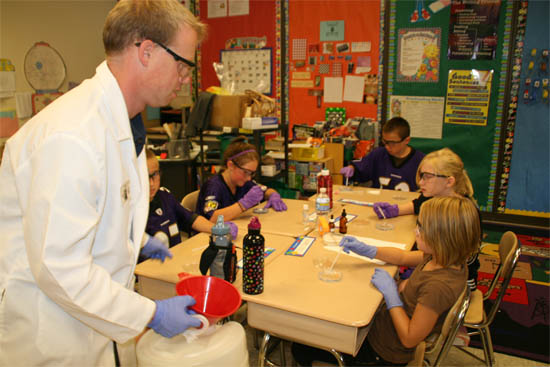From the U.S. Army Edgewood Chemical Biological Center:
The U.S. Army Edgewood Chemical Biological Center (ECBC)’s Community and Educational Outreach Program, partially funded by the National Defense Education Program, recently provided nearly 80 of North Harford Elementary School’s fifth-grade students with real-world engineering and science projects.
“A focus of the Center’s community and educational outreach program is to start exposing children to science, technology, engineering and math (STEM) experiences as early as possible and teaching them how to solve problems using methods like the engineering design process,” said Community and Educational Outreach Manager Mary Doak. “Bringing real scientists and engineers into the classroom makes the pursuit of a STEM career path such as environmental engineering more tangible for students.”
ECBC Environmental Toxicologist Michael Simini, Ph.D. and Environmental Engineer Bruce Steltzer teamed up to familiarize students with the application of science and engineering principles that help tackle the array of environmental challenges the global community faces today.
“Following the engineering design process helps us get the job done at the end of the day, right?,” Steltzer rhetorically asked during his presentation. “When approaching a problem, we first ask questions, come up with an idea, make a plan, create a solution and improve it at the end.”
Addressing the increasingly important issue of water, air and land pollution, ECBC’s outreach activities supplemented the lessons embedded in the school’s inquiry-based Engineering is Elementary (EiE) curriculum. The EiE curriculum reinforces elementary schools’ science concepts by engaging children in problem-solving through engineering activities.
The ECBC team turned three fifth-grade classrooms into laboratories, equipped students with proper equipment including safety glasses, gloves, petri dishes and pipettes and provided materials such as water, oil, baking soda and the surfactant “soap” to effectively engage students in real-life experiences.
Exposing students to the simulation of a miniature oil leak, the Center’s subject matter experts encouraged them to find solutions to a real-world problem while applying the scientific method. The challenge of this activity consisted of researching which material most effectively dispersed a drop of dyed oil from the water in the petri dish in front of them and recording their observations.
In addition, Simini explained the effects of environmental pollution and soil contamination on the food chain process emphasizing the cyclical nature of the world’s ecosystem.
“Everything in our environment is interconnected,” he said. “If one area ? air, land or water ? is polluted or contaminated, the other ones are automatically affected and suffer from the consequences.”
He distributed live earthworms in petri dishes and demonstrated how his team at ECBC uses them to determine soil contamination levels based on their reactions. In following through with two different types of experiments, fifth-graders at North Harford Elementary School learned about earthworms’ attraction to clean water and their avoidance of vinegar-contaminated space.
“These experiments are a great kind of way to learn about the environment and they are supportive of our curriculum,” said fifth-grade teacher Melanie Kane. “It was nice that they [ECBC guest speakers] took a look at our curriculum and selected hands-on activities that strongly supplemented our courses.”
“It is great when our kids get the chance to experiment and try things out,” she added.
Another fifth-grade teacher Jennifer Covert shared the excitement for the educational excursion ECBC and some of its workforce members delivered.
“These real-life experiences provided a phenomenal opportunity to be connected to the outside world and use STEM activities to solve environmental problems,” she said.
The amount and type of questions students asked kept ECBC experts on their toes and showed their deep interest for the engineering field. Involving elementary children in STEM-related activities provided the opportunity to reinforce their early motivation and expand their technological knowledge and skills.
“I thought it was really fun,” said fifth-grade student Jennifer Moran. “The experiments today helped me better understand what we learn in class.”
Attending one of the educational outreach sessions, Harford County Public Schools Supervisor of Science Andrew Renzulli praised ECBC’s efforts in creating a stimulating STEM learning environment in North Harford Elementary School’s fifth-grade classrooms.
“The experiments that kids are engaged in here and today directly support our efforts to integrate engineering at the elementary level within our science program,” Renzulli said. “For students to be able to see practicing engineers will leave a long-lasting impression and potentially encourage them to pursue a STEM career.”
“On behalf of HCPS, I’d like to express our appreciation for the educational partnership with ECBC, and we look forward to the ongoing efforts of promoting STEM experiments in the classroom,” he added.
For more information about ECBC and its community and educational outreach programs, visit http://www.ecbc.army.mil/.

ECBC Environmental Engineer Bruce Steltzer assists North Harford Elementary School fifth-grade students Trent Barnes, Olivia Davis, Andrey Miller, Alayna Beck and Julia Howard (left to right) with conducting their oil clean-up experiments.

ECBC Environmental Toxicologist Michael Simini, Ph.D. oversees the earthworm experiment and verifies the results at the table of Cadi Glick, David Sexton, Alayna Dorbert and Laura Olchewski (left to right).
Photo credit Jennifer Carroll U.S. Army Edgewood Chemical Biological Center



Leave a Reply
You must be logged in to post a comment.